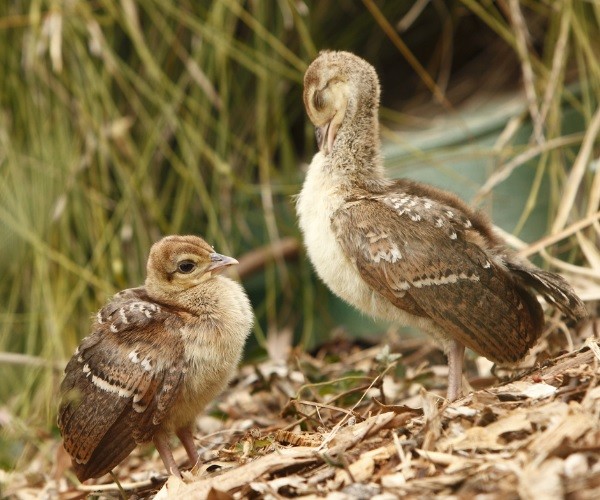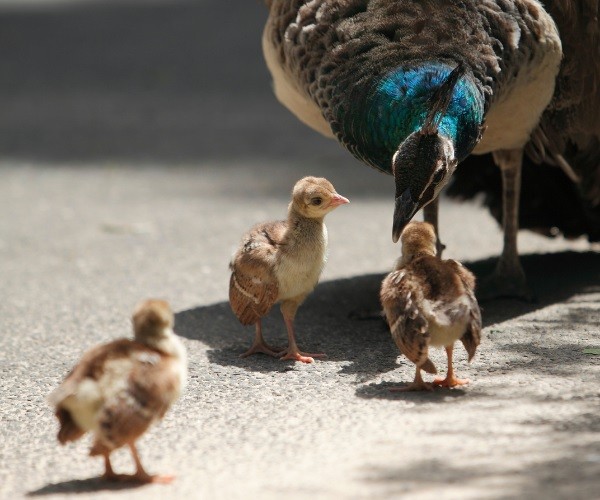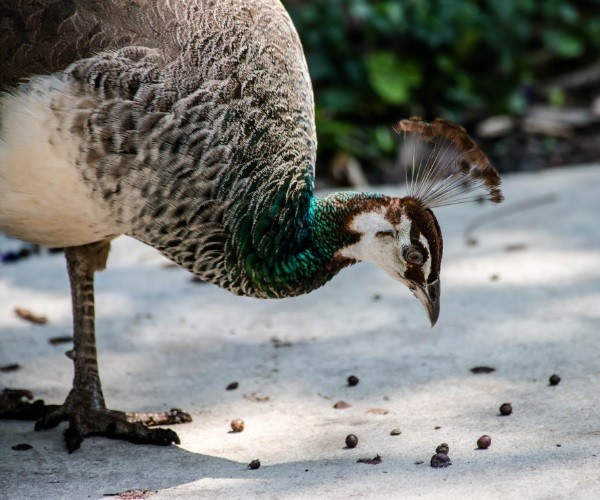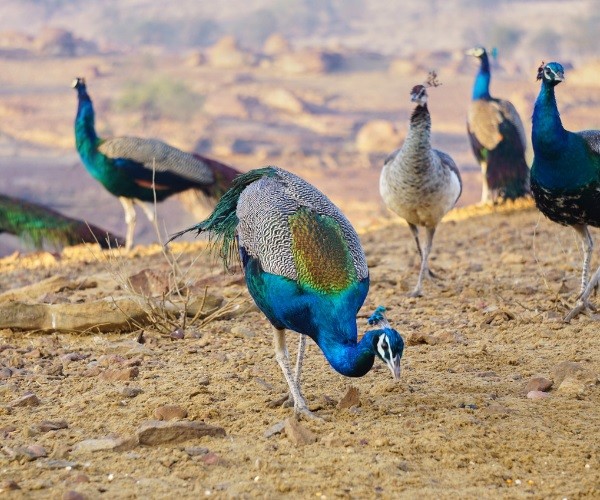Peacocks are pheasant-like birds with two Asian species: The Indian peafowl of the Indian subcontinent, the green peafowl of Southeast Asia, and one African species, the Congo peafowl.
Although they all have an omnivorous diet, there are a few key differences between them. This post will discuss some fascinating facts about what they eat and how they get it.
A short word on terminology: the male peacock is the peacock, while the female is the peahen. The peafowl is the collective name for the group. Peacocks will be used for both males and females in this article.
What do Baby Peacocks Eat?

Unlike many other birds, baby peacocks are highly mobile from the moment they are born and feed themselves. It only takes a week for them to be able to fly.
For the first few weeks of their lives, many baby peacocks will follow their mother and eat predominantly adult foods. Once they learn how to scavenge for food correctly, they are practically self-sufficient.
Taking care of baby peacocks is critical to feed them properly if you want them to grow into strong, healthy peacocks. It is essential to establish an appropriate feeding schedule.
Baby peacocks in the wild begin to hunt for food around the age of 3–4 days, consuming insects, small animals, seeds, grains, and berries. Baby peacocks can exist without food for 24–48 hours after hatching because they absorb the yolk sack.
Baby peacocks should be fed medicated game crumb for six to eight weeks in captivity. Following that, the peachicks will feed on Game Grower One. The feeding pattern shifts to Game Grower Two around 12 weeks.
Crumbed hard-boiled eggs, cat chow or cheese, and kitchen scraps are also favorites of baby peacocks. Keep the food in a covered specialized bird feeding container.
This will keep the baby peacock’s feces from contaminating the area and causing disease or infection. The food must also be kept dry, and it must be available to the peacocks whenever they want it.
The Best Food to Feed Baby Peacocks

1. Processed Feeds
Processed feeds are the best choice because they provide all peacocks’ nutrients to thrive. Processed feeds are high in protein and fiber, carbs, vitamins, minerals, and other nutrients in appropriate amounts (according to the bird’s age).
Starter chicken feed is not recommended for your newborn peacocks since it lacks the necessary proteins to grow as quickly as possible. Depending on the bird’s age, typical chicken meals contain 16-25 percent crude protein.
2. Mealworms
The larvae of the mealworm beetle are known as mealworms. Mealworms are a unique food option for your peacocks because they can also be used to reward your peachicks during training.
3. Insects and Other Small Invertebrates
On the other hand, tiny creatures make up a large portion of the peacock’s food in the wild. These indicate that if you want your baby peacocks to grow more naturally, you should feed them more insects and other small invertebrates (or allow them to hunt for them).
Peacocks Can Eat a Variety of Invertebrates in the Wild, Including:
- Earthworms
- Nematodes
- Spiders
Peacocks can consume lizards, amphibians, snakes, and other vertebrates and invertebrates. Because of the risk of dangerous bacteria, if you are brooding your baby peacocks in a brooder box (i.e., they are not with their mother), it will be helpful if you feed them processed feed and very few insects and other small creatures.
Baby peacocks can use veggies hung from the roof or ceiling as a green piata when bored. You can also combine veggies with other sorts of bird meals.
4. Vegetables
Vegetables that you should feed to your peacocks include:
- Cabbage
- Broccoli
- Lettuce
Both adult peacock and peachicks should have access to fresh water. Peacocks should be given water from covered containers to reduce the risk of drowning.
What do Peacocks Eat?

Peacocks are opportunistic omnivores at their best. Grains, grasses (such as bamboos), berries, leaves, figs, seeds, flowers, insects, worms, and small reptiles and mammals are their favorite diets.
They will even raid planted crops like tomatoes and peppers on occasion. Their nutrition is solely determined by what is available at the time, determined by the season and region.
Oil palm and African breadfruit, for example, are more likely to be found in the Congo peafowl’s diet. Peacocks in Gujarat, India, enjoy eating the berries of various buckthorn trees. Different dietary patterns can be found throughout their complete product line.
Like many other birds, Peacocks have evolved to eat a plant-based diet. They have a specialized organ called a gizzard placed near the digestive system and help them break down food.
This organ aids in the grinding of complex grains and other plants. Pebbles will be swallowed and stored in the peacock’s gizzard to help grind.
Peacocks forage during the day in the wild. They sleep in big groups at night, usually hidden in tall and open trees, and then split up in the morning to seek food in smaller groups. They generally take a mid-day break to preen feathers while relaxing in the shade and then return to foraging one last time before dusk falls.
Peacock foraging groups usually have an equal number of males and females during the non-breeding season. However, the foraging party is reduced to a harem with a single dominant male and multiple breeding females when the breeding season begins. The other males are left to forage in bachelor groups.
Peacocks are supposed to perform an essential ecological function in controlling snakes, lizards, insects, and other common animals. This helps to keep the ecosystem from being dominated by a single animal.
What Grains do Peacocks Eat?
Peacocks like to eat a variety of cereals, including oats and corn. They do not have many food preferences.
What do Peacocks Eat in the Wild?

Peacocks in the wild eat grains, berries, leaves, insects, and other omnivorous foods. In captivity, they are frequently fed a mixture of pellets, chopped greens, chopped fruits, bread, cooked rice, corn, and other food items to mimic their natural omnivorous diet.
Because captive peacocks are less vulnerable to famine, predation, and disease, they can survive for a long time (some studies suggest up to 30 or 40 years).
However, if they become excessively sedentary, difficulties occur. Peacocks in the wild must continually wander about searching for food, but they frequently expect food to come to them in captivity. As a result, they may develop gout and kidney difficulties, which can shorten their lives.
What do Peacocks Eat in the Winter?
Peacocks do not have a set winter diet, but they respond to seasonal shifts by switching to other food sources.
How do Peacocks Feed on the Snakes?
Snakes appear to be natural hazards to peacocks, not merely food supplies. Whether the snakes are deadly or not, these birds will attack them on sight by pecking at them on the ground. They are so revered for their propensity to consume baby cobras that their name means “snake killer” in Sanskrit (a South Asian language).
Last Updated on January 14, 2025 by Pauline G. Carter

